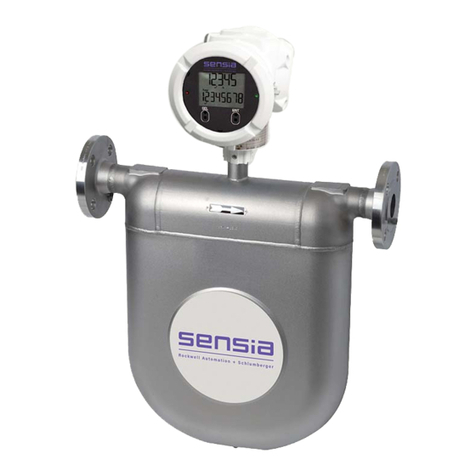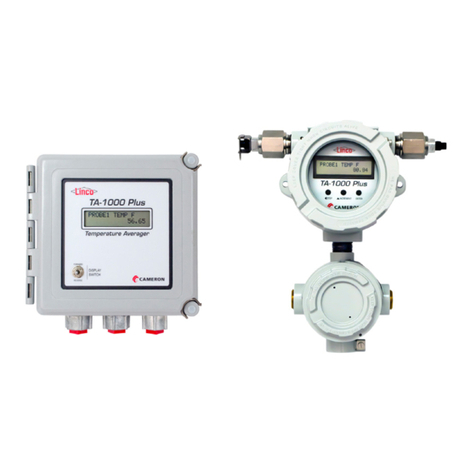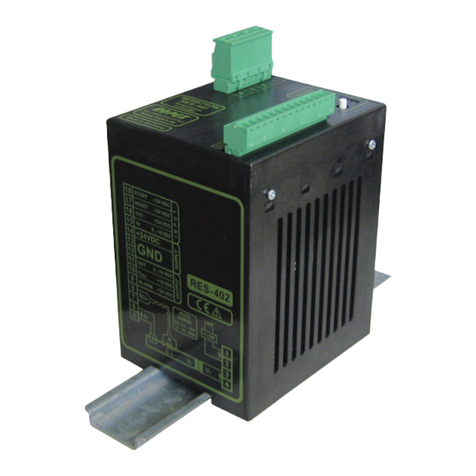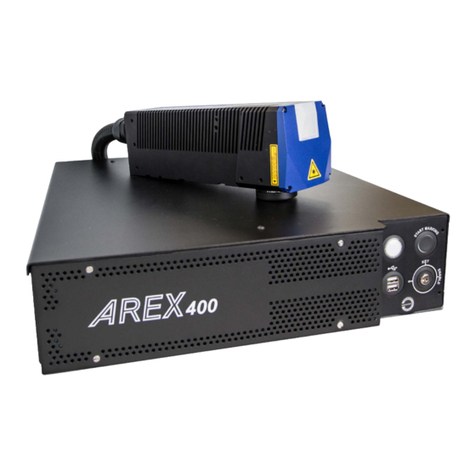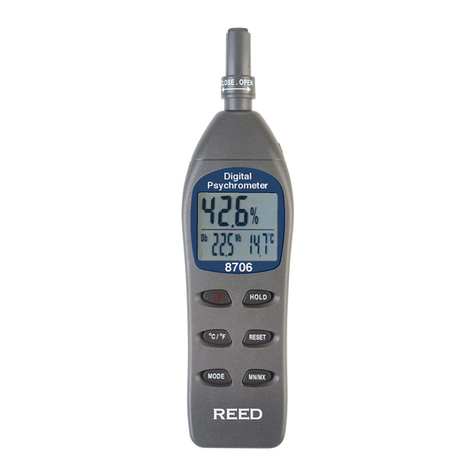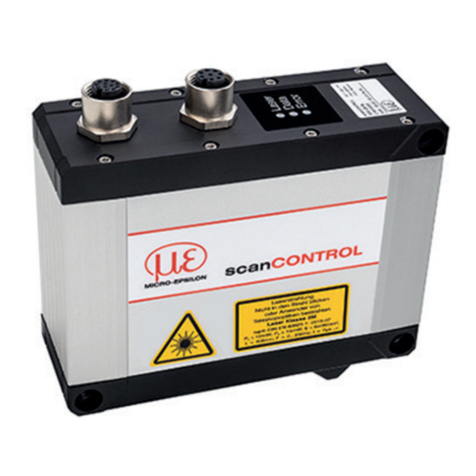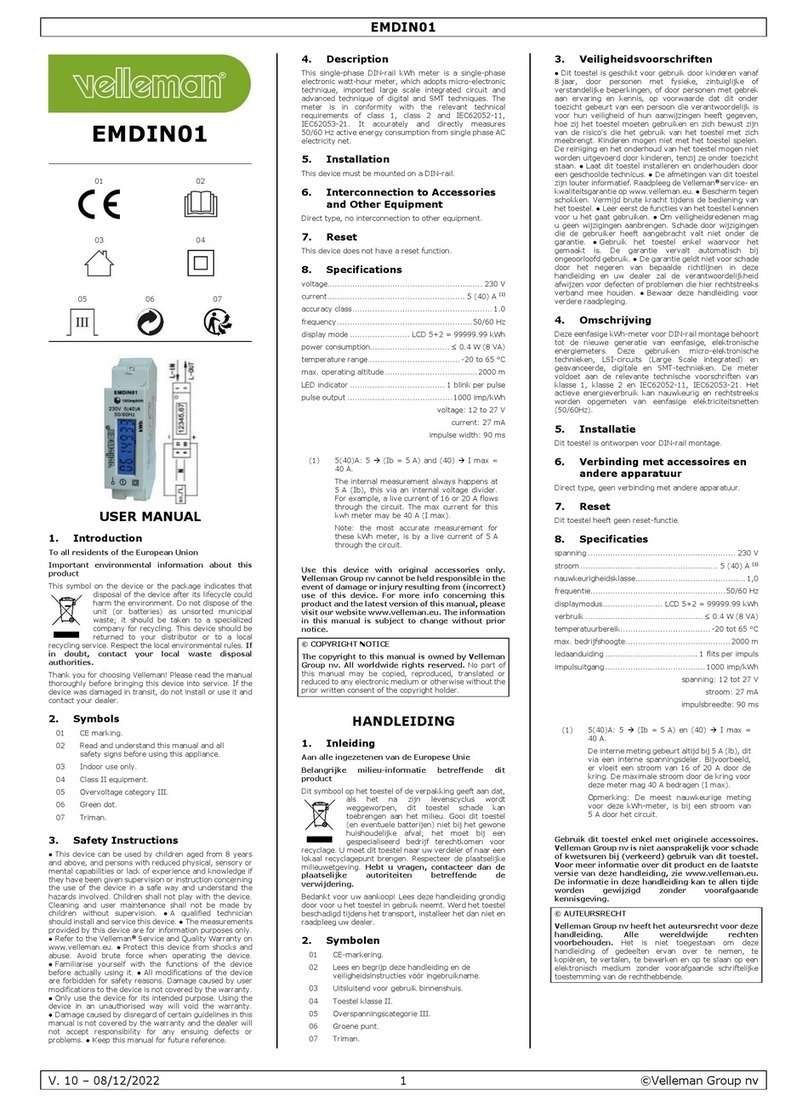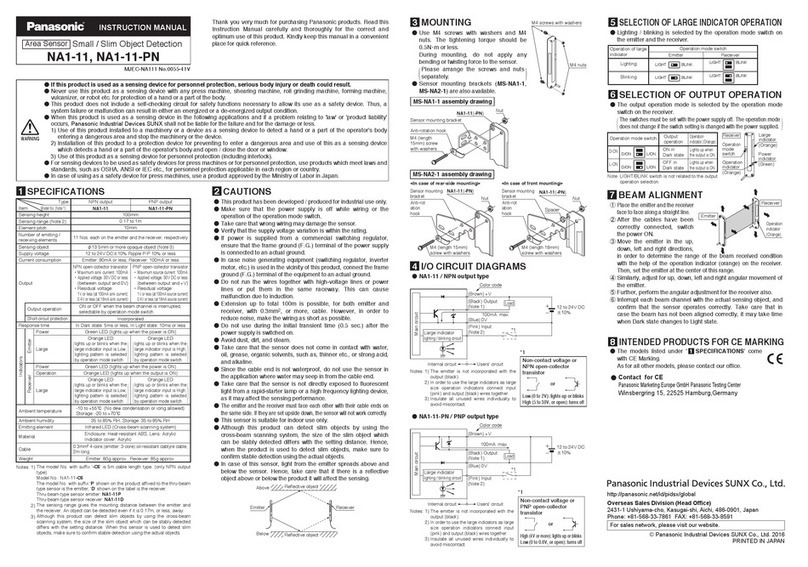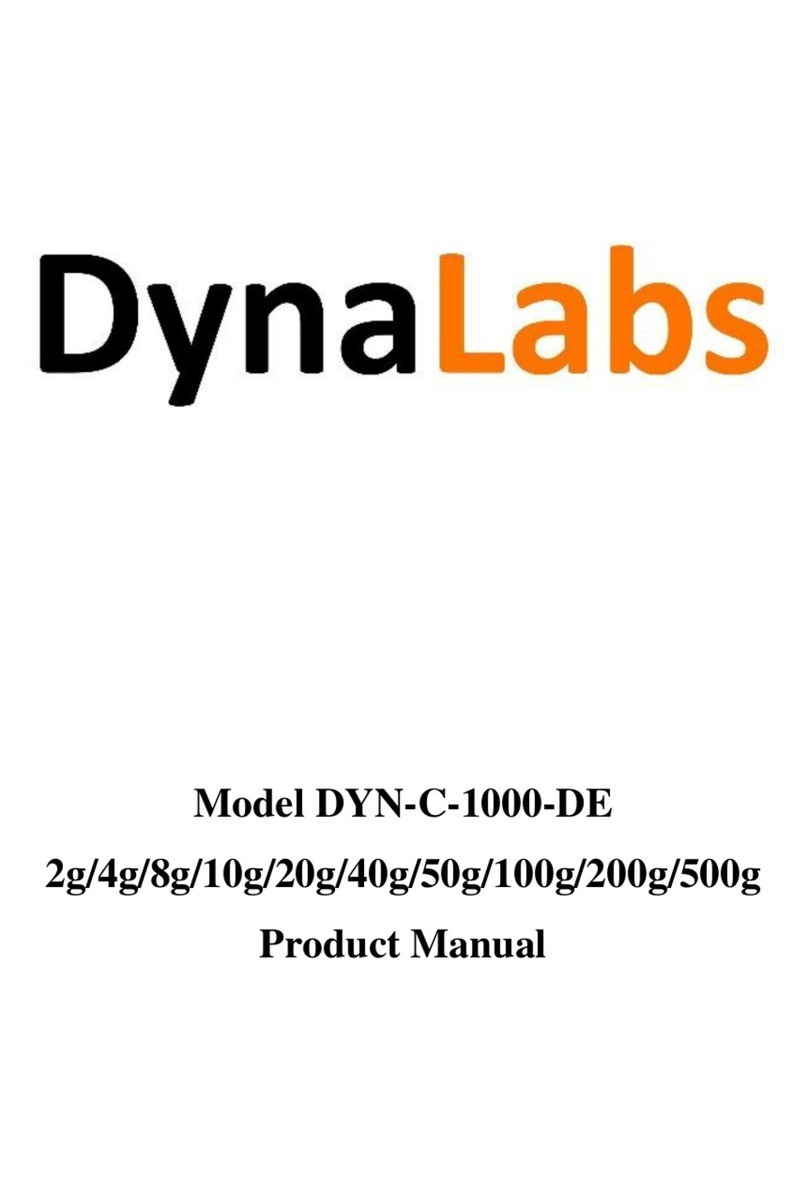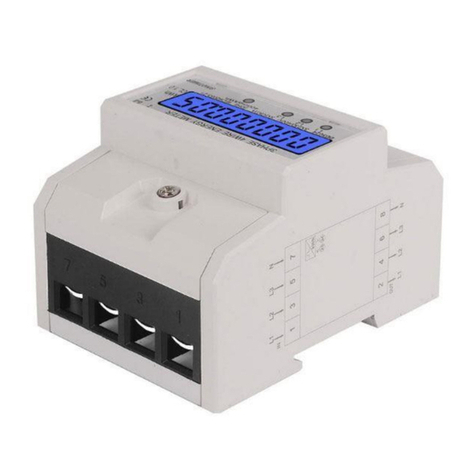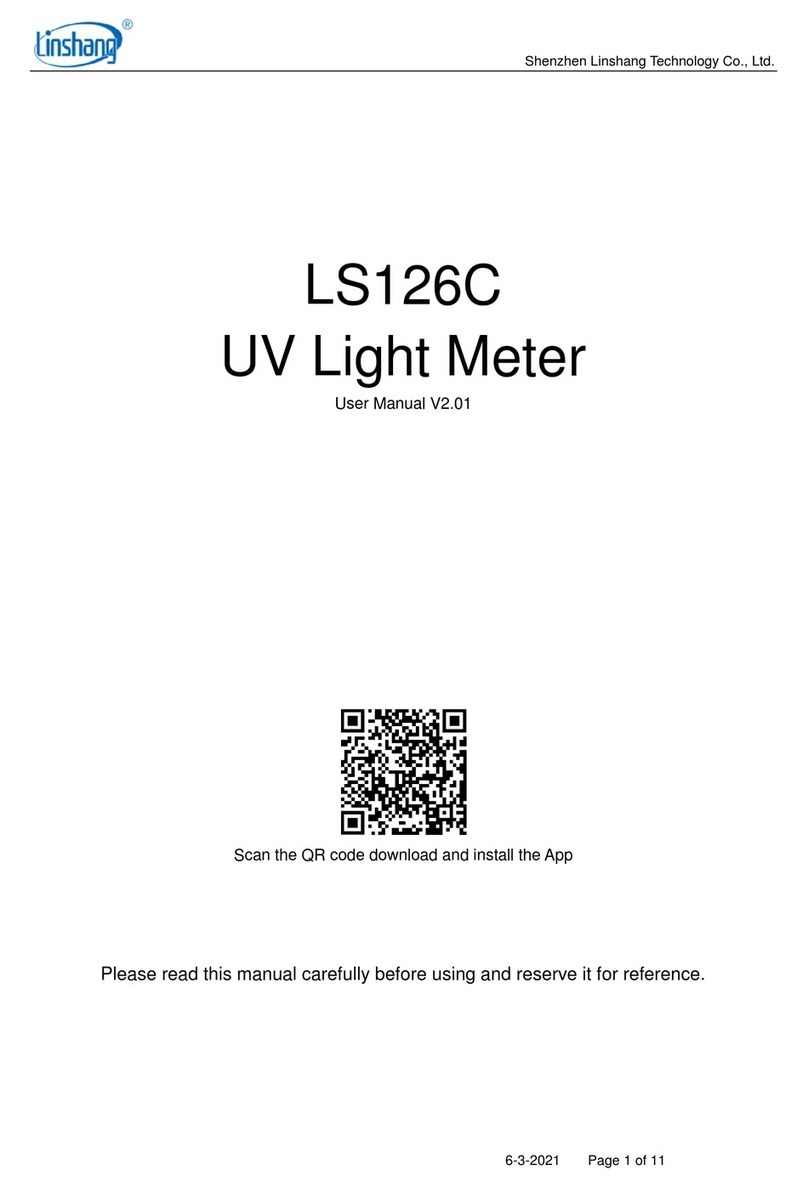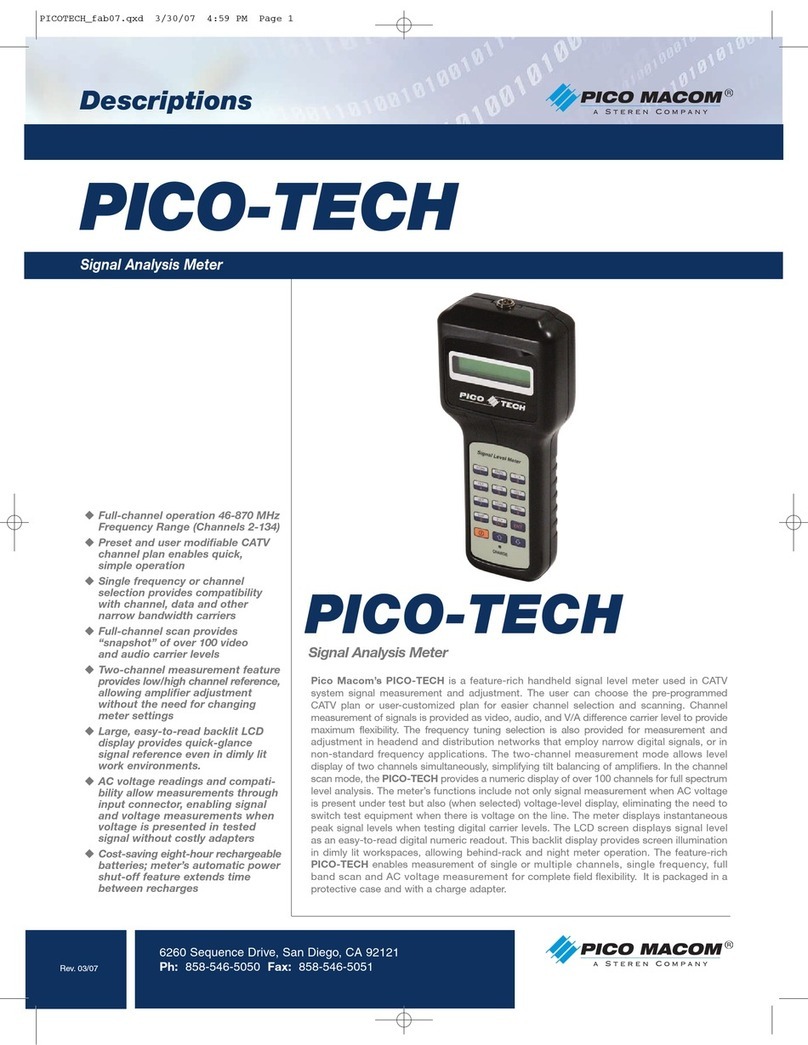Sensia NuFlo User manual

NUFLOTM
2-inch Gas Flowmeter
User Manual
Manual No. 9A-100079591, Rev. 01

All Rights Reserved.
Printed in the United States of America.
Manual No. 9A-100079591, Rev. 01
September 2009

September 2009 iii
Table of Contents
Section 1—Introduction................................................................................. 5
Operating Principles ...........................................................................................................5
Specications ......................................................................................................................6
Section 2—Setup and Calibration............................................................... 11
Installation.......................................................................................................................... 11
Calibration of Electronic Readout Equipment................................................................ 11
Absolute Pressure and Temperature .........................................................................12
Calculating Gas Volume in Actual Cubic Feet...........................................................12
Calculating Gas Volume in Standard Cubic Feet...................................................... 13
Determining the Divisor for Readout in Standard Cubic Feet .................................13
Effects of Supercompressibility .................................................................................14
Calibrating Equipment for Readout in Standard Cubic Feet Per Unit of Time ......14
Effects of Fluctuating Temperatures..........................................................................15
Effects of Fluctuating Pressures................................................................................16
Section 3—Maintenance ............................................................................. 21
Removing and Replacing Cartridges...............................................................................21
Flowmeter Assemblies......................................................................................................22
Spare Parts.........................................................................................................................22
Accessories .......................................................................................................................22

iv September 2009

September 2009 5
Section 1
Introduction
The NuFlo 2-in. Gas Flowmeter is a turbine owmeter, housed inside an insert element that is placed between
two raised-face anges. Continuous stud bolts draw the anges together against the housing element, and
gaskets on the face of the anges and meter body help ensure a competent seal. Bolts, nuts, and gaskets are
available as part of an optional hardware installation kit.
All internal components—the rotor and shaft assembly, bearings, and setscrews—are contained within a car-
tridge inside the meter. Three different cartridges are available to accommodate high, standard, and low ow
ranges (see Figs. 1.2 through 1.4, pages 3 through 5).
An electromagnetic pickup screwed into the receptacle on the side of the meter produces the output signal.
Figure 1.1—Flowmeter components
Operating Principles
The gas to be measured is owed through the meter. As the gas passes the rotor, it impinges against the
pitched rotor blade, causing the rotor to spin at a speed directly proportional to the velocity of the gas stream.
As the rotor spins, its blades interrupt the magnetic eld set up by the pickup. This interruption induces a
voltage in the coil of the pickup. The readout instrument senses this voltage pulse and converts it into a usable
form that indicates gas volume.

6 September 2009
Specications
Size 2-in. (50.8 mm)
End Connections Flowmeter installs between two raised face
anges
Working Pressure 0 to 2220 psig (15,306 kPa)
Nominal Calibration Factor
Low Range 325 p/ACF (16600 p/m3)
Standard Range 125 p/ACF (4415 p/m3)
High Range 70 p/ACF (2472 p/m3)
Output Frequency 5 to 320 Hz over rated range
Output Voltage 30 mV peak to peak at 5 Hz, 900 mV peak to peak
at 320 Hz
Pressure Drop Less than 1-in. (24.5 mm) water column at maxi-
mum rated ow
Linearity +/- 2% of reading
Repeatability +/- 0.5% of reading
Temperature 0º to 225ºF (-18º to 107ºC)
Pickup Connector Mates with AN3106A-10SL-4P
Conduit Connection 1-in. (25.4 mm)
Pressure Tap 1/8-in. NPT (3.2 mm)
Compliances CSA Certied Hazardous locations Class I,
Groups A, B, C, D, Div. 1, ANSI 12.27.01-2003
Single Seal
Certied by Cameron in compliance with pre-
qualied materials of NACE MR0175/ISO 15156.
This certication does not imply or warrant the
application of the product in compliance with
NACE MR0175/ISO 15156 service conditions in
which the customer/user installs the product.

September 2009 7
Figure 1.2—High gas ow range
where
Q(.6) = Flow rate on graph at operating pressure
G = Sp. Gr. of other gas
Q(g) = Flow rate for other gas
Flow rate ranges are based on 0.6 Sp. Gr. gas.
To determine capacity for other gases, use:
2832000
1416000
566400
283200
141600
56640
28320
14160
5664
2832
1416
566.4
283.2
141.6
56.6
28.3
2000
(13800)
1000
(6900)
500
(3450)
200
(1380)
100
(690)
50
(345)
20
(138)
10
(69)
5
(34.5)
2
(13.8)
1
(6.9)
1
2
5
10
20
50
100
200
500
1000
2000
5000
10000
20000
50000
100000
CU. M/DAYMCFD(SCFM)
(69444.4)
(34722.2)
(13888.9)
(6944.4)
(3472.2)
(1388.9)
(694.4)
(347.2)
(138.9)
(69.4)
(34.7)
(13.9)
(6.9)
(3.5)
(1.4)
(0.7)
FLOWING PRESSURE, PSIG (kPa)
(.6)
(g)
0.6
Q Q
=G

8 September 2009
Figure 1.3—Standard gas ow range
where
Q(.6) = Flow rate on graph at operating pressure
G = Sp. Gr. of other gas
Q(g) = Flow rate for other gas
Flow rate ranges are based on 0.6 Sp. Gr. gas.
To determine capacity for other gases, use:
2832000
1416000
566400
283200
141600
56640
28320
14160
5664
2832
1416
566.4
283.2
141.6
56.6
28.3
2000
(13800)
1000
(6900)
500
(3450)
200
(1380)
100
(690)
50
(345)
20
(138)
10
(69)
5
(34.5)
2
(13.8)
1
(6.9)
1
2
5
10
20
50
100
200
500
1000
2000
5000
10000
20000
50000
100000
CU. M/DAYMCFD(SCFM)
(69444.4)
(34722.2)
(13888.9)
(6944.4)
(3472.2)
(1388.9)
(694.4)
(347.2)
(138.9)
(69.4)
(34.7)
(13.9)
(6.9)
(3.5)
(1.4)
(0.7)
FLOWING PRESSURE, PSIG (kPa)
(.6)
(g)
0.6
Q Q
=G

September 2009 9
Figure 1.4—Low gas ow range
where
Q(.6) = Flow rate on graph at operating pressure
G = Sp. Gr. of other gas
Q(g) = Flow rate for other gas
Flow rate ranges are based on 0.6 Sp. Gr. gas.
To determine capacity for other gases, use:
2832000
1416000
566400
283200
141600
56640
28320
14160
5664
2832
1416
566.4
283.2
141.6
56.6
28.3
2000
(13800)
1000
(6900)
500
(3450)
200
(1380)
100
(690)
50
(345)
20
(138)
10
(69)
5
(34.5)
2
(13.8)
1
(6.9)
1
2
5
10
20
50
100
200
500
1000
2000
5000
10000
20000
50000
100000
CU. M/DAYMCFD(SCFM)
(69444.4)
(34722.2)
(13888.9)
(6944.4)
(3472.2)
(1388.9)
(694.4)
(347.2)
(138.9)
(69.4)
(34.7)
(13.9)
(6.9)
(3.5)
(1.4)
(0.7)
FLOWING PRESSURE, PSIG (kPa)
(.6)
(g)
0.6
Q Q
=G

10 September 2009

September 2009 11
Section 2
Setup and Calibration
Installation
The NuFlo Gas Flowmeter must be installed properly to prevent gas from swirling or experiencing other er-
ratic ow characteristics. Figure 2.1 shows the proper installation of the meter.
*10 nominal pipe diameters is the minimum recommended upstream pipe length.
If a ow straightener is not used, longer upstream pipe lengths may be required
to minimize measurement uncertainty due to swirl or asymmetrical ow.
Figure 2.1—Typical installation of an in-line gas turbine meter (minimum lengths). Upstream and downstream
sections are available in Schedule 40 and Schedule 80 pipe.
Calibration of Electronic Readout Equipment
Before a owmeter leaves the factory, it is calibrated at multiple points within the ow range of the cartridge;
the factor is given in pulses per actual cubic foot (acf). This factor, which is recorded on a calibration tag that
is attached to the meter, is then used to calibrate electronic readout equipment in the eld.
Fluid measured by the gas turbine meter is compressible, and is also affected by temperature changes. The
volumetric change caused by temperature and/or pressure for any ideal gas follows the equation below:
1 1 2 2
1 2
P V P V
T T
=

12 September 2009
Absolute Pressure and Temperature
The equation above shows that the volume of gas is determined by pressure and temperature. In this equation,
the pressure, P, is absolute pressure (the owing or observed gauge pressure plus the atmospheric pressure).
The commonly used unit of measure for absolute pressure is pounds per square inch absolute (psia). For this
purpose, atmospheric pressure is considered to be 14.73 psi. Therefore,
Absolute pressure (psia) = Observed gauge pressure (psig) + 14.73 psi
The absolute temperature in the equation above is expressed in degrees Rankine, which is calculated as fol-
lows:
Degrees Rankine = Flowing gas temperature (°F) + 459.67
Calculating Gas Volume in Actual Cubic Feet
As a point of reference for discussing volumetric units of gas, one cubic foot (1ft3) of gas at a pressure of 1
atmosphere (assume 14.73 psia) at a temperature of 60°F (519.69°R) is considered one standard cubic foot
(scf). A cubic foot of gas at any other pressure and temperature is referred to as an actual cubic foot (acf) and
has no signicance unless the conditions of pressure and temperature are known. For example, given 1 acf
of gas at 200 psig at 100°F, the volume of gas at standard conditions may be calculated with the following
formula:
( )
( )
3
3
3
standard pressure volume observed pressure 1 ft
standard temperature observed temperature
200 14.73 1 ft
14.73 volume
519.67 100 459.67
214.73 519.67
Volume 559.67 14.73
Volume 13.536 ft
× ×
=
+ ×
×=+
×
=×
=
Therefore, 1 ft3 of gas at 200 psi and 100°F would occupy a volume of 13.536 ft3 if the pressure and tem-
perature were reduced to standard conditions of 0 psi (14.73 psia) and 60°F. Numerous laboratory tests
have shown that the NuFlo Gas Flowmeter produces the same number of pulses per actual cubic foot of gas
regardless of the pressure and temperature of the gas when operated within its rated range. As a result, the
calibration factor can be specied in pulses per actual cubic foot. If the readout equipment for a gas meter
and the totalizer register in actual cubic feet, the ow totalizer divisor is set to the nearest whole number to
the calibration factor. The counter will then register actual cubic feet, regardless of the owing pressure and
temperature.
Example: Assume a 2-in. gas owmeter with a calibration factor of 124.96 pulses per actual
cubic foot, a owline pressure of 70 psig, and a temperature of 80°F.
If the readout equipment divisor is set for 125, totalizer measurements will be in actual
cubic feet; if the readout equipment divisor is set for 1,250, totalizer measurements
will be in tens of actual cubic feet.

September 2009 13
Calculating Gas Volume in Standard Cubic Feet
Generally, gas is measured in standard cubic feet rather than actual cubic feet. Remember, at standard condi-
tions (0 psi and 60°F), standard cubic feet and actual cubic feet are equivalent.
To convert actual cubic feet to standard cubic feet, use the following formula:
f s
s f
Actual Cubic Feet P T
Standard Cubic Feet P T
× ×
=×
where
Pf = ow pressure (psia)
Ps = standard pressure (14.73 psia)
Tf = owing temperature (°R)
Ts = standard temperature (519.67°R)
Example How many standard cubic feet are in each actual cubic foot at a owing pressure of 70 psig
and a owing temperature of 80°F?
( )
( )
1.0 70 14.73 519.67
Standard Cubic Feet 5.539
14.73 80 459.67
× + ×
= =
× +
The example above shows that there are 5.539 scf in every actual cubic foot at the owing conditions of 70
psi at 80°F. The number of standard cubic feet may be obtained by setting the ow totalizer for the calibration
factor of the gas meter as previously described, and multiplying the registration by 5.539.
Example A 2-in. gas turbine owmeter with a calibration factor of 124.36 pulses per actual cubic foot
is installed in a owline operating at 70 psig at 80°F. The ow totalizer divisor is set at 1,244
for registration in tens of actual cubic feet. Assume that during a 24-hour period, the totalizer
registers 2,327 counts. How many standard cubic feet were metered during this period?
Standard cubic feet = 2327 × 10 × 5.539 = 128,893
Determining the Divisor for Readout in Standard Cubic Feet
If the owing conditions are kept constant, the multiplier for converting actual cubic feet to standard cu-
bic feet will also remain constant. To simplify operations, consider this when computing the divisor for the
readout equipment and provide a direct readout in standard cubic feet. The following formula can be used to
determine the divisor for any given set of operating conditions:
s f
f s
FCF P T
Divisor P T
× ×
=×

14 September 2009
where
FCF = owmeter calibration factor (pulses/acf)
Ps = standard pressure (14.73 psia)
Pf = owing pressure (psia)
Tf = owing temperature (°R)
Ts = standard temperature (519.67°R)
Example A 2-in. gas turbine meter has a calibration factor of 124.36 pulses per actual cubic foot, and
is installed in a owline operating at 70 psi at 80°F. Calculate the divisor for a ow totalizer to
register in standard cubic feet.
( )
( )
124.36 14.73 80 459.67
Divisor 22.452
70+14.73 519.67
× × +
= =
×
A divisor of 224 should be used for readings in tens of standard cubic feet, a divisor of 2,245
should be used for readings in hundreds of standard cubic feet.
Effects of Supercompressibility
The procedures described in this manual are applicable only when the owing pressure and temperature
remain constant at the values used in the computation. If an application has a line pressure greater than 200
psig, the operator should consider the effects of supercompressibility and adjust the divisor accordingly.
The equation for calculating a divisor that allows for supercompressibility is
s f
2
f s pv
FCF P T
Divisor = P T (F )
× ×
× ×
where Fpv = supercompressibility factor
Calibrating Equipment for Readout in Standard Cubic Feet Per Unit of Time
The readout equipment’s ow rate indicator and/or analog rate output may also be calibrated for the owing
conditions to provide registration in standard cubic feet per unit of time.
The rate indicator will produce the full-scale output selected when the gas turbine meter generates the fre-
quency corresponding to that output. The following formula may be used to calculate the full-scale frequency
for any particular readout device:
s f
f s
FSFR FCF P T
FSF TBCF P T
× × ×
=× ×

September 2009 15
where
FSF = full-scale frequency (Hz)
FSFR = full-scale ow rate (scf/unit time)
FCF = owmeter calibration factor (pulses/acf)
Ps = standard pressure (14.73 psia)
Tf
= owing temperature (°R)
TBCF = time-based conversion factor (seconds/unit time)
Pf = owing pressure (psia)
Ts = standard temperature (519.67°R)
Example Calculate the full-scale frequency for the readout in the previous example if the full-scale ow
rate is 1,500 Mscf/D.
( )
( )
1,500,000 124.36 14.73 80 459.67
FSF 389.78 Hz
24 hr 60 min 60 sec 70+14.73 519.67
day hr min
× × × +
= =
× × × ×
The readout device should indicate 1500 Mscf/D ow with a 389.78 Hz signal fed into the
owmeter signal input.
Effects of Fluctuating Temperatures
In some applications, temperature does not remain constant and the operator must determine to what degree
changing temperatures affect readout accuracy. In many cases, changes in temperature will not produce seri-
ous measurement errors and can often be ignored. However, where temperature changes are more extreme,
the user may recalibrate the readout equipment seasonally to offset the impact of wide ranges of temperature
changes from summer to winter.
Figure 2.2 illustrates how uctuations in owing temperature cause errors in standard cubic feet.
To determine the effect of temperature changes on readout accuracy, see the example below.
A 2-in. gas turbine owmeter is installed in a owline operating at 70 psig at 80°F. At standard conditions,
1 ft3 of gas will occupy 5.539 ft3. Determine the effects of a 10% change in temperature.
10% of 80° = 8°; therefore, the maximum temperature is 88°F and the minimum temperature is 72°F.
At 88°F,
( )
( )
1.0 70 14.73 519.67
Standard Cubic Feet 5.458
14.73 88 459.67
× + ×
= =
× +
At 72°F,
( )
( )
1.0 70 14.73 519.67
Standard Cubic Feet 5.622
14.73 72 459.67
× + ×
= =
× +

16 September 2009
At 80°F, each actual cubic foot equaled 5.539 scf. The percentage of change caused by increasing the ow
temperature to 88°F is shown below:
5.539 5.458
% Change 100 -1.46 %
5.539
−
= × =
The percentage of change caused by decreasing the ow temperature to 72°F is shown below:
5.622 5.539
% Change 100 1.50 %
5.539
−
= × =
Effects of Fluctuating Pressures
In some applications, pressure does not remain constant and the operator must determine to what degree
changing pressures affect readout accuracy. Small changes in pressure can produce large errors in standard
cubic feet, especially at low owing temperatures. Figure 2.3 illustrates the effect of uctuations in owing
pressure on standard cubic feet. Note how the effect of changing pressure is much greater than the effect of
changing temperature. The overall effect of changing temperature and pressure is the algebraic sum of the
individual effects.
To determine the effect of pressure changes on readout accuracy, see the example below.
Example A 2-in. gas turbine owmeter is installed in a owline operating at 70 psig at 80°F. At
standard conditions, 1 ft3 of gas will occupy 5.539 ft3. Determine the effects of a 10% change
in temperature.
10% of 70 psig is 7 psig; therefore, the maximum pressure is 77 psig and the minimum pres-
sure is 63 psig.
At 63 psig,
( )
( )
1.0 63 14.73 519.67
Standard Cubic Feet 5.081
80 459.67 14.73
× + ×
= =
+ ×
At 77 psig,
( )
( )
1.0 77 14.73 519.67
Standard Cubic Feet 6.000
80 459.67 14.73
× + ×
= =
+ ×
At 70 psig, each actual cubic foot equals 5.539 scf.
The percentage of change caused by reducing the owing pressure to 63 psig is shown
below:
5.081 5.539
% Change 100 -8.27 %
5.539
−
= × =
The percentage of change caused by increasing the owing temperature to 77 psig is shown
below:
6.000 5.539
% Change 100 8.32 %
5.539
−
= × =

September 2009 17
When faced with varying owing pressures, consider the following alternatives:
1. Sense the pressure on the owline and correct the output from the owmeter.
2. Control the pressure to hold it constant within the limits of error that can be tolerated.
Alternative No. 1 requires a pressure-compensated readout, or the use of a computer that can receive a sign
representing pressure and compensate for the owmeter signal.
Alternative No. 2 is normally the least expensive since it requires only the installation of a pressure regulator
in the owline downstream of the owmeter.

18 September 2009
Figure 2.2—Effect of change in temperature on gas volume measurements. Positive and negative changes in temperature produce virtually the
same error.
12.0
10.0
8.0
6.0
4.0
2.0
0
0 20 40 60 80 100 120 140 160 180 200
Flowing Temperature, F°
Percentage of Error in Gas Volume Readout
10 F Change°
20 F Change°
30 F Change°
40 F Change°
50 F Change°
% Error = Variation in Temperature ( Fahrenheit)°
Flowing Temperature ( Rankine)°

September 2009 19
Figure 2.3—Effect of change in pressure on gas volume measurements. Positive and negative changes in pressure produce virtually the same
error.
30
25
20
15
10
5
0
0100 200 300 400 500 600 700 800 900 1000
Flowing Pressure, psi
Percentage of Error in Gas Volume Readout
20-psi Change
30-psi Change
40-psi Change
50-psi Change
10-psi Change
% Error = Variation in Gage Pressure (psig)
Absolute Flowing Pressure (psia)

20 September 2009
Table of contents
Other Sensia Measuring Instrument manuals

Sensia
Sensia Barton 306 User manual

Sensia
Sensia NUFLO MC-III User manual
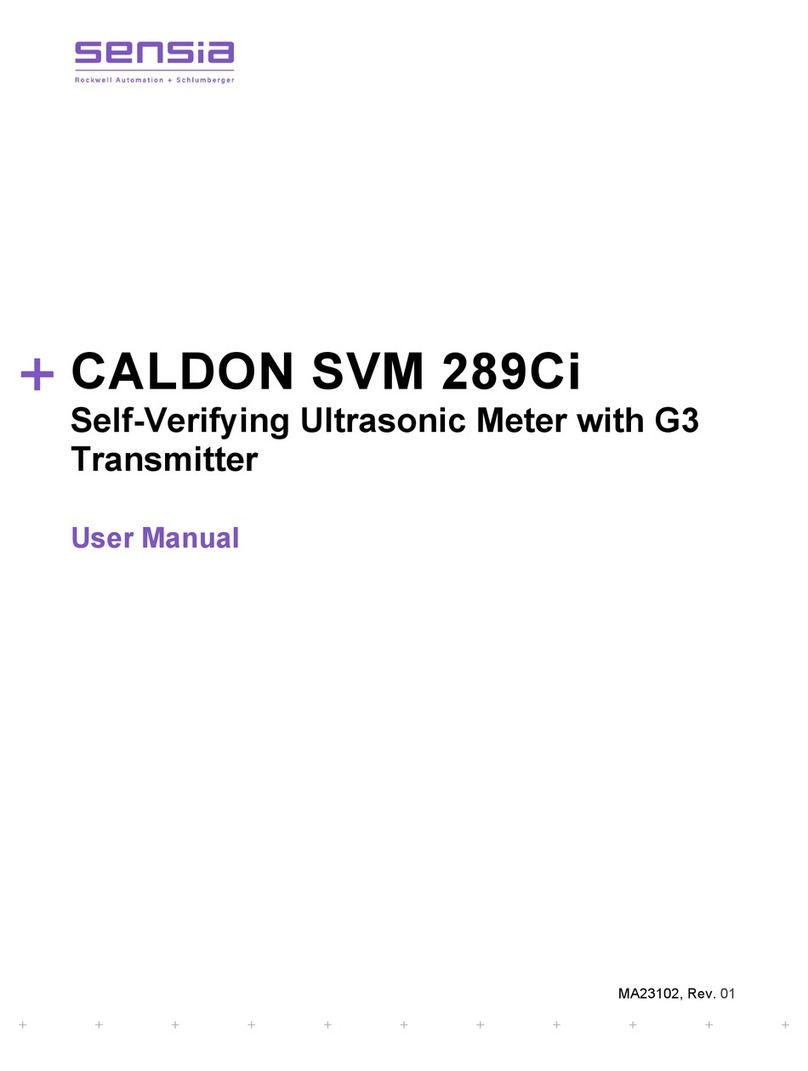
Sensia
Sensia CALDON SVM 289Ci User manual
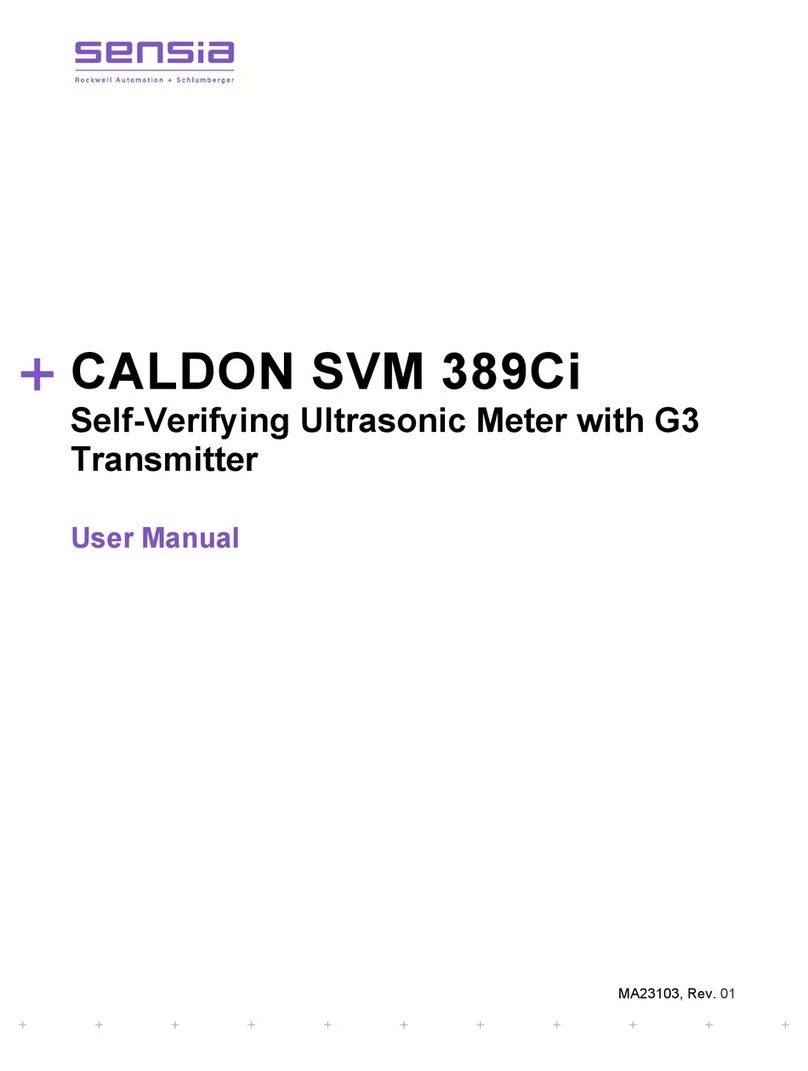
Sensia
Sensia CALDON SVM 389Ci User manual

Sensia
Sensia NUFLO TMP-100 User manual
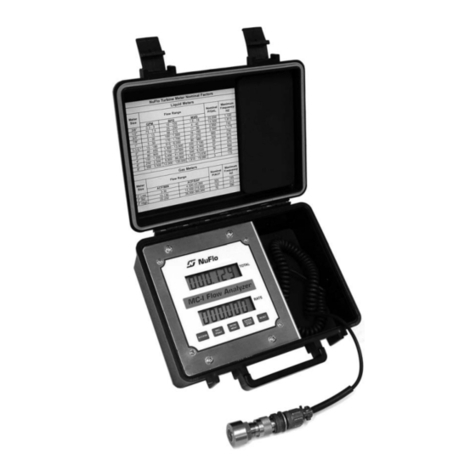
Sensia
Sensia NUFLO MC-I User manual
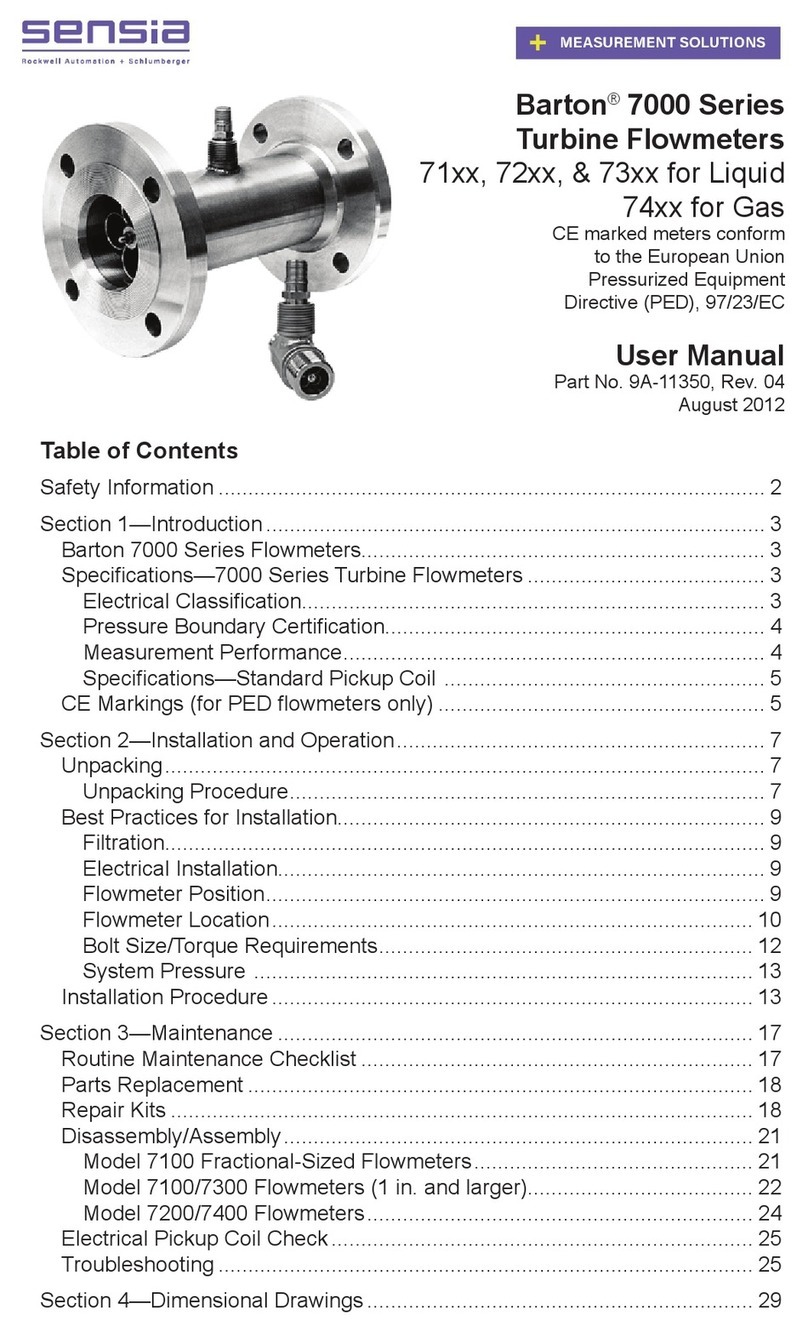
Sensia
Sensia Barton 7000 Series User manual
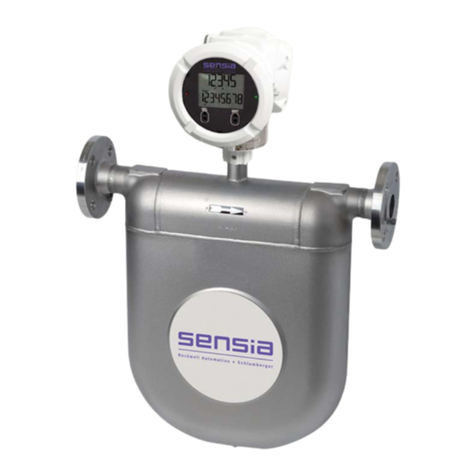
Sensia
Sensia CamCor User manual
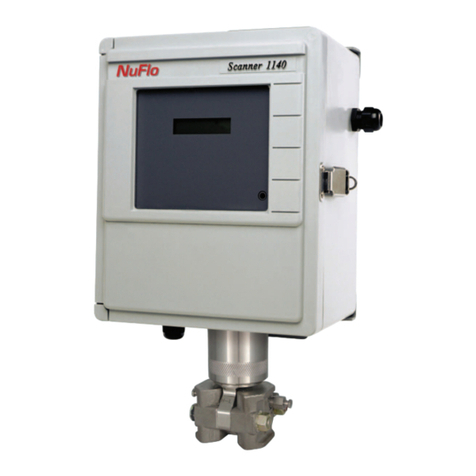
Sensia
Sensia NUFLO Scanner 1140G User manual
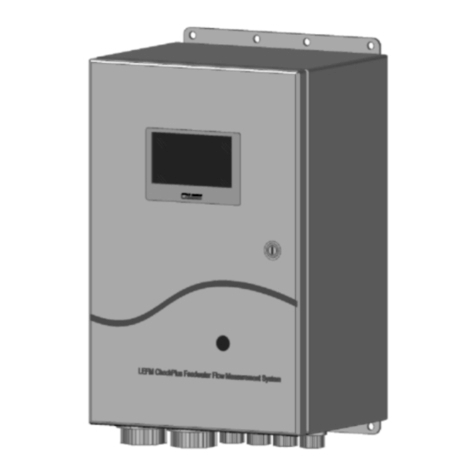
Sensia
Sensia CALDON LEFM CheckPlus-C User manual

